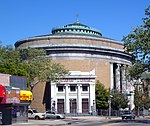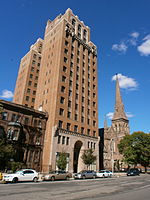Malcolm X Shabazz High School

Malcolm X Shabazz High School is a four-year comprehensive public high school in Newark in Essex County, in the U.S. state of New Jersey, as part of the Newark Public Schools. Founded as South Side High School in 1912, the school was renamed in 1972 in memory of Malcolm X. The school is a candidate for accreditation by the Middle States Association of Colleges and Schools Commission on Elementary and Secondary Schools.As of the 2021–22 school year, the school had an enrollment of 273 students and 30.5 classroom teachers (on an FTE basis), for a student–teacher ratio of 9.0:1. There were 218 students (79.9% of enrollment) eligible for free lunch and 13 (4.8% of students) eligible for reduced-cost lunch.
Excerpt from the Wikipedia article Malcolm X Shabazz High School (License: CC BY-SA 3.0, Authors, Images).Malcolm X Shabazz High School
West Bigelow Street, Newark
Geographical coordinates (GPS) Address External links Nearby Places Show on map
Geographical coordinates (GPS)
| Latitude | Longitude |
|---|---|
| N 40.718974 ° | E -74.191804 ° |
Address
Malcolm X Shabazz High School
West Bigelow Street
07108 Newark
New Jersey, United States
Open on Google Maps






